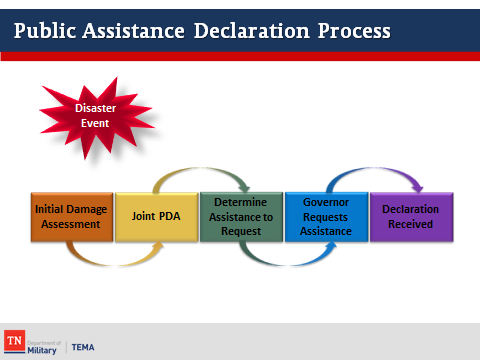The Federal Declaration Process

Federal Disaster Assistance
Most emergencies must be borne by the victims of the disaster, but some are large enough to request government assistance. The federal government financially assists local and state governments and its citizens to recover when the emergency is a disaster.
Under the Stafford Act (federal law), a community requesting federal assistance must prove they have been overwhelmed by events. Not only must the local government must be overwhelmed, but state capabilities must be overwhelmed as well. Any request to the President for federal assistance must reflect how local capabilities have been exceeded.
As a foundation to this proof, the local government should declare a local emergency (by proclamation of the mayor) under Tennessee Code Annotated 58-2-104. A survey must be performed by local emergency officials (which may be assisted by the TEMA) to decide if the damages in the county will meet pre-determined threshold amounts based upon population, and to determine if a state threshold amount based upon population has been met as well. Both thresholds must be met before the county is eligible to apply for federal assistance under the Stafford Act. The mayor (or the local emergency management director acting for the mayor) must request a declaration of state emergency by the Governor. Federal assistance usually cannot be provided without a state declaration of emergency also.
Thresholds
Two thresholds must be met under the Stafford Act, a state threshold and a county threshold. These thresholds are based on a pre-determined legal formula that disaster damages must exceed. The formula uses population of the jurisdiction as determined in the last official U.S. Census which is then entered to multiply population by $3.89 per capita for counties and $1.55 per capita for the state. The state threshold equates to about $9.8 million. The minimum project amount is $3,320.00, and the small project threshold is $132,800.00. These figures are for FY 2021.
To determine whether a threshold will be met, the local government and TEMA partner in an informal survey ("windshield survey") to estimate the damages incurred in the jurisdiction. This estimate is collected by the state to determine the total damages of all jurisdictions involved in the event and whether the combined amounts may exceed the threshold amounts. When the estimate is near or over the threshold amounts, the Governor may request FEMA to provide preliminary damage assessment (PDA) teams or federal officials who do a more thorough review with state authorities to make the official determination. The PDA is used to determine whether federal disaster funds will be provided.
Types of Disaster Assistance
There are various types of disaster assistance available from the Federal Emergency Management Agency (FEMA) and/or the U. S. Small Business Administration. The assistance includes:
- Individual assistance-For Homeowners and Renters
- Public assistance-For Cities, Counties, and certain Private Non-Profit Organizations
- SBA loans- For Homeowners, Rentrrs, and Small Businesses
Each of these types of federal assistance offers differing types of help. None of these options provide all encompassing funds that will fully replace losses, but they do assist in starting recovery. Often, a local community has volunteer disaster organizations that offer services, materiel, loans or cash to further assist in the difference. The government does not typically coordinate the award of non-government disaster assistance, but when it is availble TEMA will direct deserving persons to the appropriate contact.
Persons who have incurred losses should register with FEMA: Apply For Assistance.